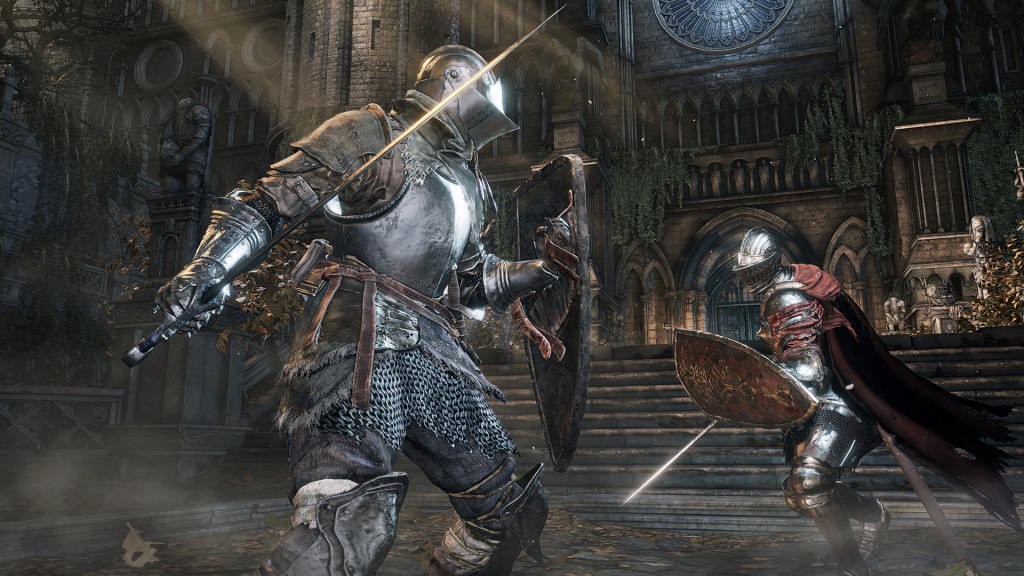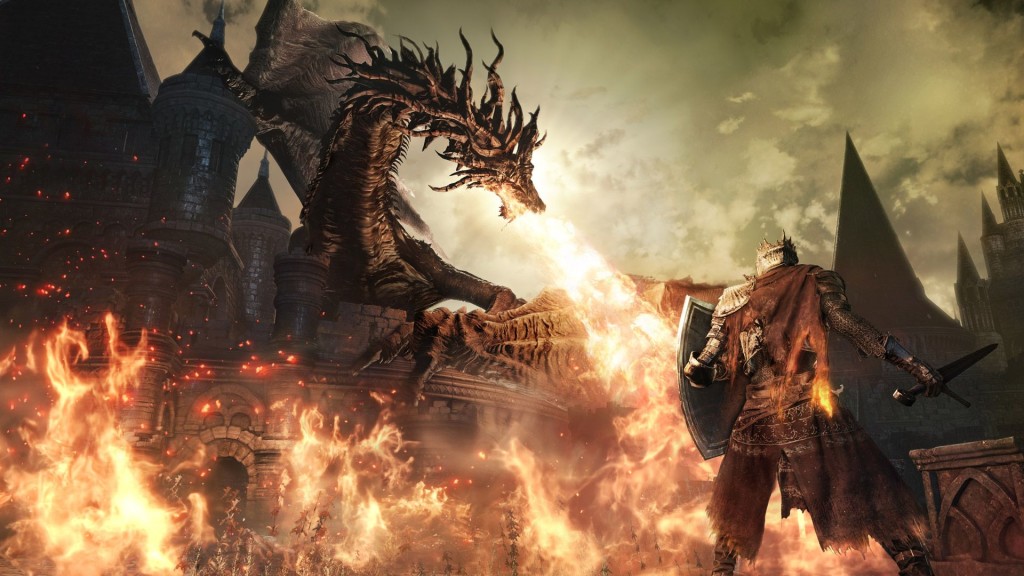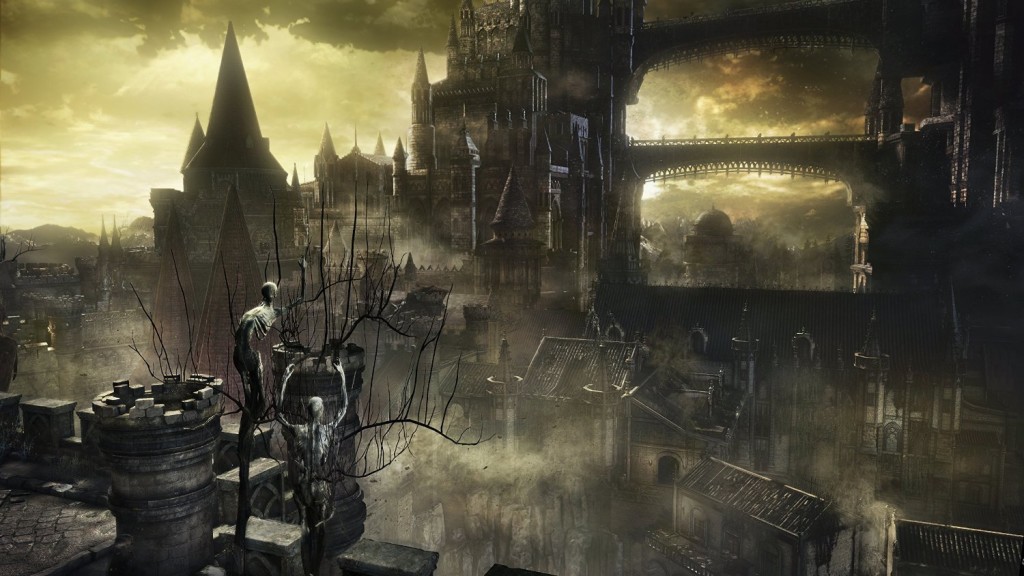 After playing Dark Souls III for around 3 hours or so last night, I think that’s enough time to really identify a lot of the game’s inner workings:
After playing Dark Souls III for around 3 hours or so last night, I think that’s enough time to really identify a lot of the game’s inner workings:
- Combat received a notable speed boost; most people attribute this to Bloodborne, and while I haven’t played that title, its action-focus seems like a intentional inspiration to Dark Souls III’s design. Enemies attack faster with a lot more vigor, and in greater numbers; at the same time, your attacks are much faster and you move much quicker. Consistent invincibility frames on rolling returns, giving you the means to avoid all this renewed pressure. Since it’s much easier to get stun-locked by enemies, the ability to roll out of stagger animations, and even off the ground, is a godsend of the highest degree. Simply put: fighting is fun, a lot of fun, and it solves most of the problems in the first two games (either back stab chains or boring multi-enemy fights where you wait a lot).
- Still, regardless of all that mechanical discussion, the one thing Dark Souls III has that either of its predecessors do not is the idea of risk in its combat systems. Most enemies don’t give you time to wait for an opportunity to back stab, and many of them have explicit countermeasures to prevent the typical circle-strafe strategies of the past. Blocking is much less useful overall, since enemies take out huge chunks of the stamina meter (especially in the early game). The easiest time to hit enemies is when they’re in the middle of an attack animation, right before it will hit you, since most attacks have very wide range. This is less a game of waiting to see enemy patterns, and more a game of anticipating and interrupting enemy attacks before they hit. It’s like a quick draw standoff – somebody’s going to hit the other first, and either way it’s going to be ugly.

- It goes without saying that they want you to use Weapon and Magic Arts. Dark Souls III adds an additional meter, Focus, for the use of these new attacks, and they’re quite powerful. Only, in the heat of combat and muscle memory, they’re difficult to actually perform in the middle of a tense situation. Enemies also use them to break your guard, which has made me reconsider my typical sword-and-board play style (congrats, From Software, you’ve made me switch from tank spec for a bit since it seems kinda useless right now!). In sum: they’re important, and you should use them, but they vary by weapon so expect lots of experimentation.
- Dark Souls III also regains the original tension of exploration that the original game presented so well. The distance between bonfires varies pretty wildly; careful exploration and management of resources becomes a requirement, as per usual, but the more difficult combat makes that really, really hard. As well, if you’re a magic user, you can choose to bring Ashen Flasks in lieu of Estus Flasks, which restores Focus Points – that’s a hard decision for anyone to make, and since there’s no other healing apart from spells this time (no Lifegems!), you actually need to make some tough decisions. So far, Souls don’t appear in great quantities, so there’s some difficult decisions for resource spending.

- Interestingly, while Dark Souls III cribs the teleportation between bonfires from Dark Souls II, I don’t mind it as much here; part of that comes down to Dark Souls II’s flat level design, which did make everything appear like a giant corridor. Here, From Software twists the landscape and path into devilish shapes that lack clear bearings and obvious signs to remember. They want you to get lost, or at least feel like you’re lost, despite the path being very linear. The aesthetics and enemy placement remind me of Dark Souls I, while the structure hews pretty close to Dark Souls II – it’s an interesting contrast, and one that works. People who want to explore and find intricately woven paths will be disappointed, but that’s only been in one game in the series so far – perhaps that’s just an outlier In this game, surviving its myriad encounters and reaching the bonfire seems much more essential than being able to find secret paths every three feet.
- I’m not sure what to think of the bosses yet; I beat the first two on my first try, and they seemed relatively easy. But, from what I’ve heard, the later ones turn the game on its head, more like giant dangerous puzzle boxes that require some thought to unlock. It’s hard to say how things will turn out, but I have a feeling that the early content’s here to get new and old players into the groove between yanking the rug from under their feet. So far, though, the game lacks any surprises, mostly since it’s a sequel!
All in all, I can say so far that I’m intrigued, and I’m back into the Dark Souls groove, despite playing Dark Souls II: Scholar of the First Sin a few months before this. What really matters is that is recaptures the feeling of the first game in both mechanical and aesthetic choices; you really get that sense of dread when you’re running out of supplies, or a tough enemy accosts you out of nowhere. There’s also nostalgia for the first game in play, as the character animations are almost identical to that of Dark Souls (I mean, they are seriously trying to distance themselves from Dark Souls II, from what I can tell!).
Dark Souls III is a bit like returning to an old text and re-reading it with fresh eyes; you can tell Hidetaka Miyazaki certainly did, and the prowess required to fix problems in the previous game while holding to From Software’s high standards is remarkable. Three games in three years, and none of them are abject failures – that’s gotta be a record, right? Each Souls game feels like seeing the same text with a new spin; were we that way with Christianity, perhaps we’d learn a lot more about the holy texts we so revere. Seeing old concepts with fresh eyes takes some work, but it’s definitely worth the effort!
17 Deal bountifully with Your servant,
That I may live and keep Your word.
18 Open my eyes, that I may behold
Wonderful things from Your law.Psalm 119
